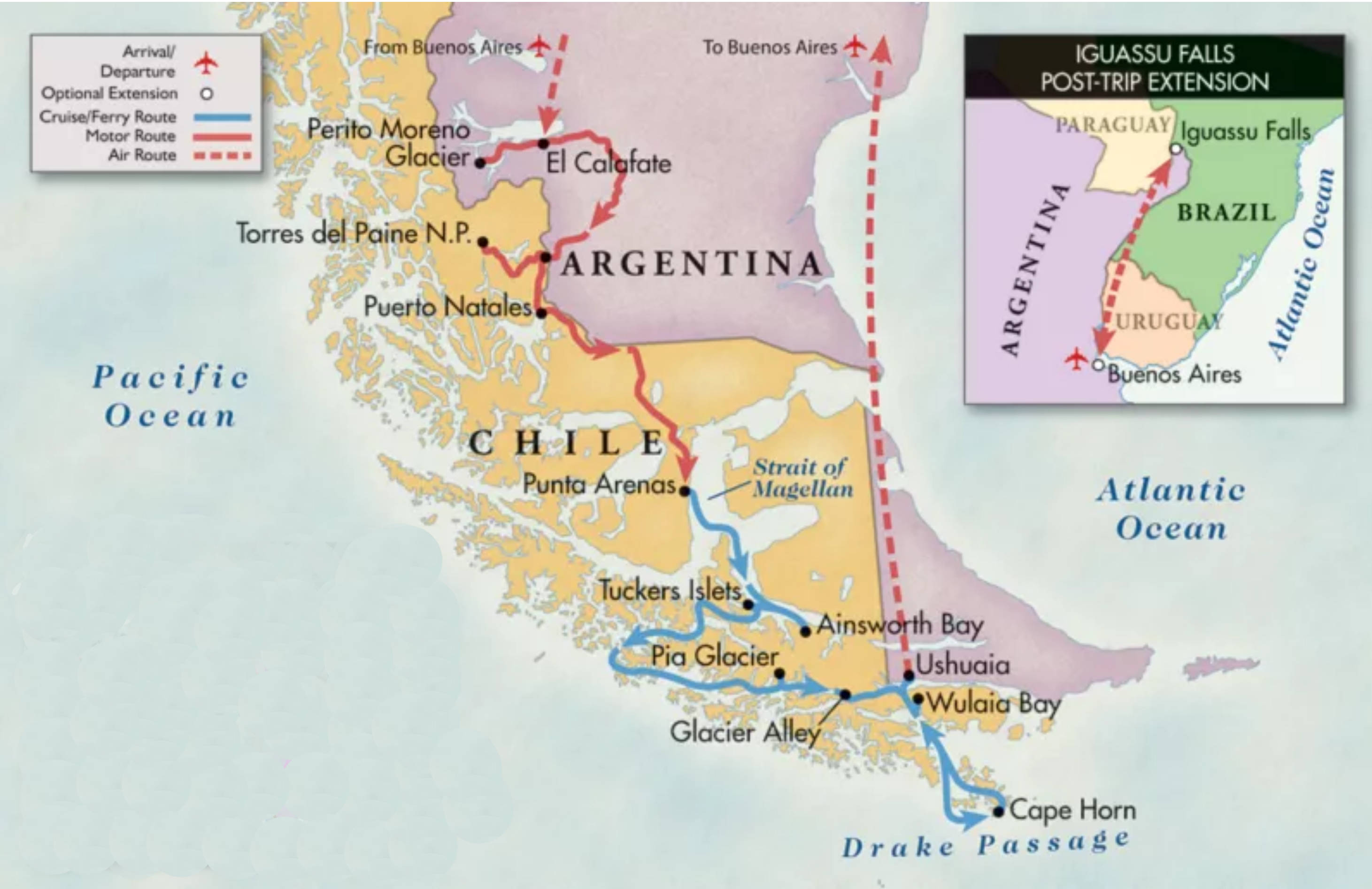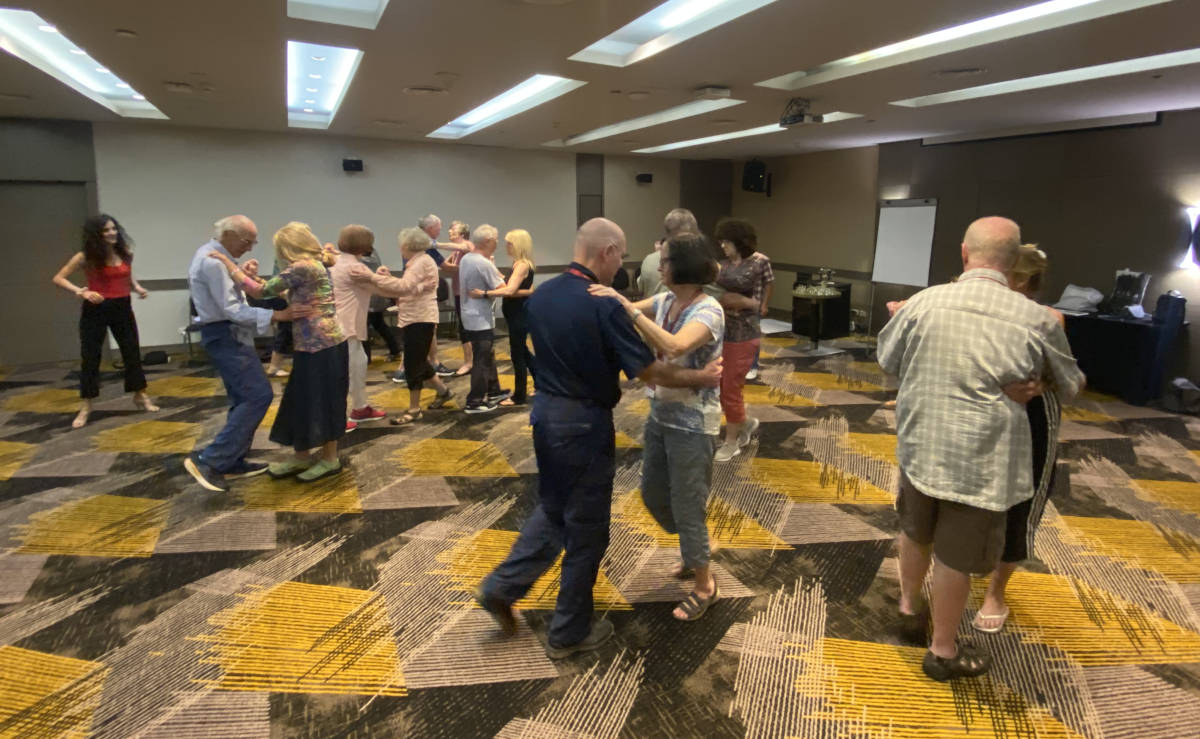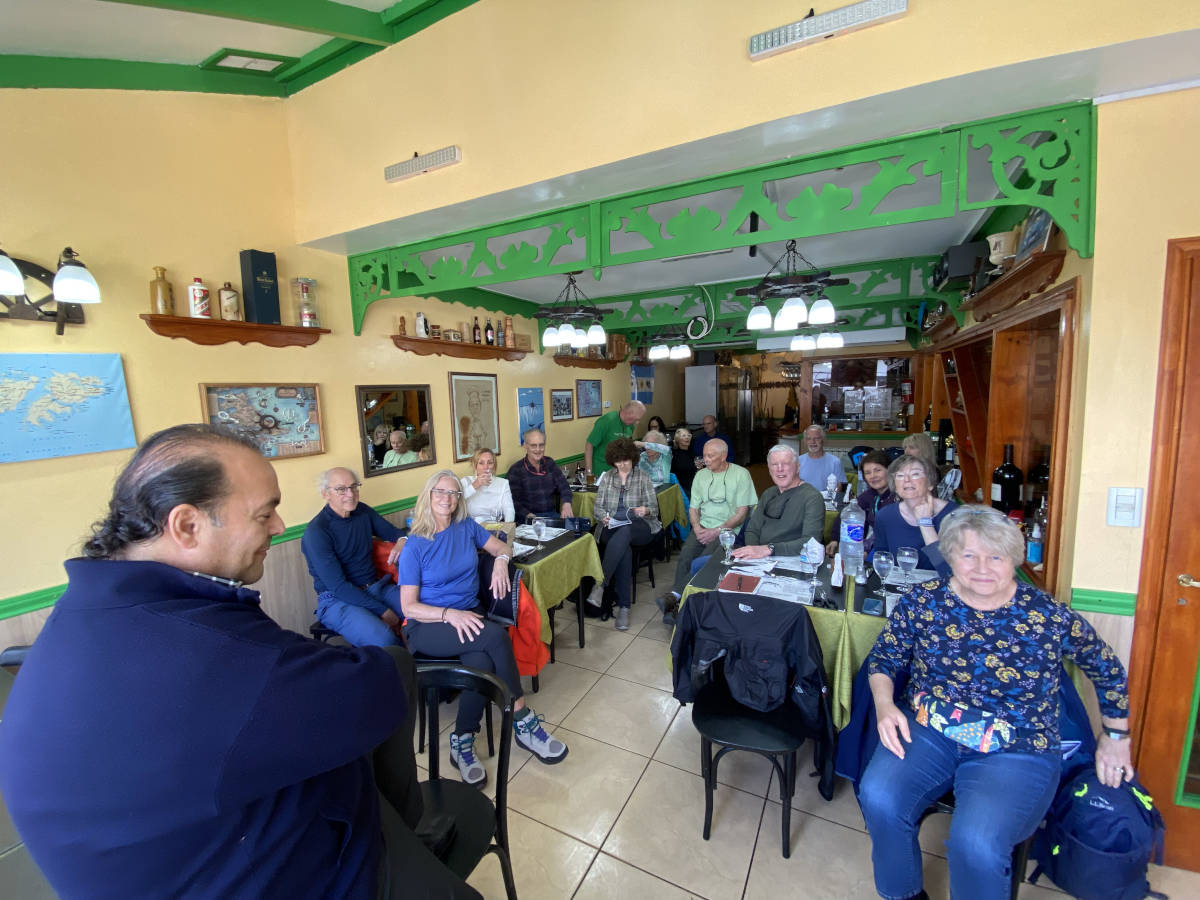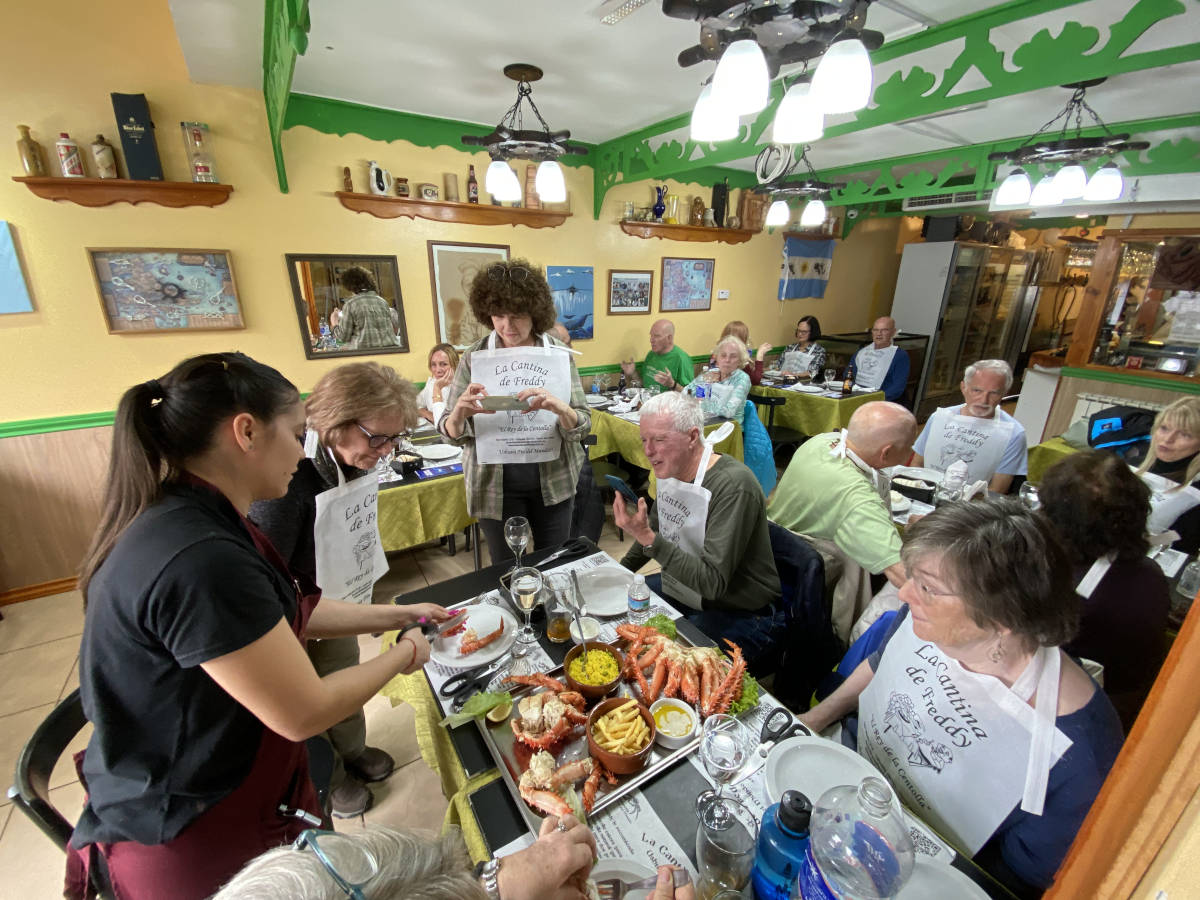Our friends Jan and Ben Mercado invited us to join them on an Overseas Adventure Tour (OAT) trip to Patagonia. Mostly a land trip, but we had 4 days on an excursion cruise ship near the beginning of the trip. We left DFW February 23 on a red eye flight and left Buenos Aires on March 14 for another red eye flight home. An OAT rep met us at the airport in Buenos Aires.
 The route we traveled was in the opposite direction of that shown on this map. Our trip started in Ushuaia and traveled to El Calafate.
The route we traveled was in the opposite direction of that shown on this map. Our trip started in Ushuaia and traveled to El Calafate.
Feb 24
We arrive in Buenos Aires and proceed in a long line through immigration.
Our room in Recoleta Grand.
There are at least two major money exchange rates. The official rate and the blue rate. Our hotel directed us to the Western Union office just down the street where we could exchange US dollars for the Argentinian Peso at the blue rate. There was a lot of confusion about which exchange rate credit cards were currently using. The difference in the rates was not quite 2:1.
Our first meal in Buenos Aires is at Los Imomortales Pizza Cafe, other the other side of a nearby park. Lots and lots and lots of cheese on a moderately thick crust. It didn't take much to fill us up.
Our hotel suggested this book store, El Ateneo as a nice destination for a nearby walk.
Originally a theatre then a cinema and now a bookstore.
View of the ceiling.
On the same walk we came upon a march in support of the Ukranian people as it was Feb 24 the first anniversary of the invasion.
A sign calling Russia a state terrorist.
As we were crossing an intersection along the parade route a young lady said I should be careful with my phone as people will snatch it out of my hand. Later we found out that one of our group had their phone taken right out of their hand that same day. They were in an area with a lot of police who quickly caught the thief. They spent 4 hours at the police station but did get their phone back.
More of the march.
We walked the same direction for a few blocks as these delightful schoolgirls!
Before heading back to the hotel, we stop for ice cream at Freddo, which we learn later is a popular place to go for dulce de leche.
Feb 25
We have a few hours before we meet up with our other OAT travelers and trip leader so we take another city walk. First we head to the mall where we had heard there's a good view of the famous Recoleta Cemetary from the upper level.
The Recoleta area is an upscale barrio. (A large part of the population of Buenos Aires and Argentina is quite poor.)
Then we walked to a local park where they had a lot of handicraft booths set up. Linda bought a wall hanging from this lady.
We like the way this statue was holding up the tree limb.
This beautiful sculpture, Floralis Generica, located in Plaza de las Naciones Unidas is made of steel and aluminum. Sculptor, Eduardo Catalano, gifted this to the city and he says it represents all the flowers in the world.
A bust of Luis Braille in French Square near our hotel in the Recoleta Barrio of Buenos Aires. Apparently he was well thought of in Argentina.
We get together for the first time with our trip leader Martin Soliani. He seemed to know and be friends with just about everybody along the trip and was better know by his childhood nickname of Tincho.
Tincho fills these glasses with Legui, an Argentinian liqueur made from sugar cane.
We learn about Tango. The instructor and her tango partner along with the female bandoneon (accordian) player.
 We have a Tango lesson. A good ice breaker. Fun fact: Tincho's wife (not on our trip) also teaches Tango!
We have a Tango lesson. A good ice breaker. Fun fact: Tincho's wife (not on our trip) also teaches Tango!
Dinner on our own again, we dine outdoors at this grill which happens to be right next door to El Ateneo bookstore!
Feb 26
We begin our day with a tour of Buenos Aires and Tincho gives us history lessons along the way.
 Located on the Avenue the 9th of July (their Independence Day), we take a group photo by the topiary letters of the city and near the white obelisk that commemorates the 400th anniversary of Buenos Aires' founding.
Located on the Avenue the 9th of July (their Independence Day), we take a group photo by the topiary letters of the city and near the white obelisk that commemorates the 400th anniversary of Buenos Aires' founding.
On our city walk we pass an entry to the Subte (subway).
Tincho takes us to Plaza de Mayo, a square where many government building are located. There's an elegant mixture of Spanish Colonial as well as traditional European styles of architecture here.
The presidential palace, Casa Rosada. Eva Peron would speak from the balcony here. The building is no longer the residence of the president but his office is still there.
The Basilica where Pope Francis served as a cardinal is also on the Plaza.
Inside the Basilica.
Grandmothers started to march against the military juntas dirty war (1974-1983) wanting to know what had happened to their disappeared grandchildren. The scarf is their symbol and a few that can still walk do so on Thursdays. The US supported the dictatorship.
We went to a memorial park for the disappeared. The remains of 10,000 of the estimated 30,000 Argentinians who were killed have been identified. The military dictatorship ruled the country from 1976 to 1983.
Manu talked about the disappeared in the memorial park. His mother was an architectural student and a member of a student organization when she was taken.
Some high school students were disappeared after just protesting for free bus rides to school.
Manu points to the name of his mother who was disappeared when he was just weeks old. He showed us a picture of her which made it so much more real and painful.
The memorial has a lot of needed wall space. How many more of the 30,000 will be found?
We take our bus to La Boca, a working class area of BA where Martin had his first apartment. The La Boca neighborhood is where the Tango started.
A couple doing the tango.
With Argentina recently winning the World Cup Lionel Messi was a pretty big deal.
The Caminito street area has street artists and brightly painted buildings.
Interesting figures (such as Eva Peron) are sometimes seen hanging from buildings!
OAT trips usually include a home visits. In Buenos Aires we visit the home of Alicia, a school teacher. She also hosts exchange students - her current student is from the US. (Our tour group was was split into two home visits groups.)
We asked her how she manages the 100% inflation in Argentina and she just kind of shrugged and said they manage. Several other people we questioned said basically the same thing.
A tapita we made.
Making our own tapitas. The filling is Dulce de Leche. The Dulce de Leche showed up often in our desserts.
Feb 27
Flying into Ushuia. The wind made for a bumpy landing. Expecting a very small town we learn that it has 90,000 inhabitants but we saw only the smaller older section around the harbor. The national government has a lot of subsidies for the region. There are a lot of electronics manufacturers in this city. Because natural gas is subsidized, gas heat is abundant and buildings are sometimes uncomfortably too warm!
We were in the last row of a 737 Max. Glad it was a short flight.
Shortly after arriving in Ushuia, we board a bus and meet our local guide Barbie.
Our hotel Celine Del Faro in Ushuia.
Lunch on our own at Tia Elvira with Jan and Ben.
We're happy with the menu! That's Pierre and Mary seated behind Emerson and Ben.
Exploring Ushuia on our own before meeting up with the group later in the afternoon.
Cannot pass up this photo op!
 Back with our group, Barbie introduces us to Ushuia.
Back with our group, Barbie introduces us to Ushuia.
The two major Malvinas Islands are depicted to the left of the letters.
A monument to The Malvinas War of 1982 (in Argentina Falklands is a bad word!) The war is still very much alive in the peoples hearts.
Several pictures of the war were close by the monument.
The young Argentinian troops.
The fate of many.
We have our second home visit.
We walked around the whole house.
It's set on a hill overlooking the harbor.
The kitchen has a photo of Gabby's 2 daughters.
Gabby and her daughter Sol made a delicious meal of Lentil stew and there were yummy sweets including brownies and tres leches!
 Gabby was warm and friendly, the perfect hostess!
Gabby was warm and friendly, the perfect hostess!
A view of the harbor from our hotel at night. We'll board one of these ships the next day to head to Cape Horn!
Feb 28
After breakfast, we had time to explore and found this interesting sculture to the first peoples of this land.
 Our group meets up at La Cantina De Freddy restaurant where we meet with a survivor of the Malvinas war. He volunteered at age 18 and didn't have much good to say about the military government's support of the troops. The British were a lot lower on his list.
Our group meets up at La Cantina De Freddy restaurant where we meet with a survivor of the Malvinas war. He volunteered at age 18 and didn't have much good to say about the military government's support of the troops. The British were a lot lower on his list.
After our talk we eat -King Crab! Fresh from the local waters.
 The waitstaff demonstrates how to successfully dismantle a crab.
The waitstaff demonstrates how to successfully dismantle a crab.
Tincho talks about king crabs.
Did we mention dessert?! Ice cream, chocolate and calafate berries.
More free time after lunch, we come across a time capsule set to be opened after 500 years!
A statue to the indigenous people. As in most places the indigenas people did not fair well after Europeans arrived.
We perused a row of artisan shops and bought a needlepoint depicting the Five Brothers Mountain from this artist.
Our first moments aboard our ship the Ventus Australis.
Introductory remarks from some of the crew.
We head up to the top deck of the ship for last views of Ushuaia. We see the two peaks overlooking the town. There's the Five Brothers on the right.
Tonight the ship enters Chile and the crew handles our immigration process.
Our first salad for our first meal - octopus! Green salads were not real plentiful on this trip.
Mar 01
Tincho with his Mate (pronounced ma'-tay).
Getting ready to board a Zodiac, Jan snaps our photo and there's Ben doing his photobomb!
The seas weren't too rough but they made sure the zodiac was stable to enter and exit. When the sea is rough they can't land and you view the island from the ship.
The island is named after the Netherlands town of Hoorn.
Welcome to the island that gives its name to Cape Horn.
In front of the monument to all of the sailers who lost their lives going around the cape. The two halves put together form an albatross, the seafaring symbol for souls lost at sea.
A pretty desolate place.
A family stays here for a year. A young lady was selling some drawings she and her younger brother had made. Unfortuanately we did not bring any money.
We would have bought something.
The chapel and playground just outside the lighthouse/residence.
It is always very windy in the summer. We had asked why we didn't see windmills and they said the wind doesn't blow enough in the winter. Too bad they can't store the summer breeze.
We head back down to waiting Zodiacs to head back to our ship.
We visit the bridge of our ship.
They do a manual plot of our route. On the last night they auction the chart off with the procedes split amoungst the crew. This chart went for $1000 USD.
Wednesday evening in Wulaia Bay. Just beautiful.